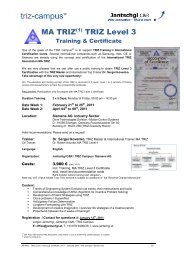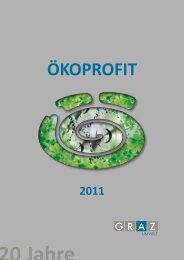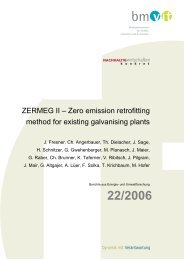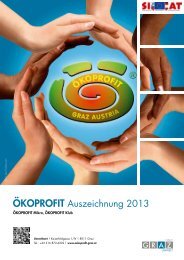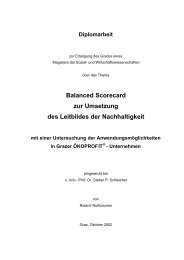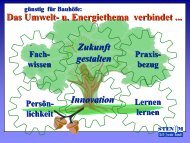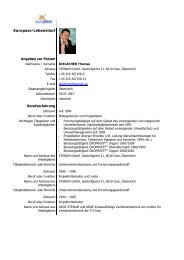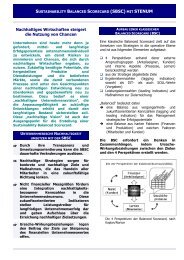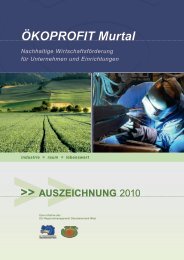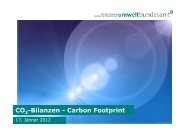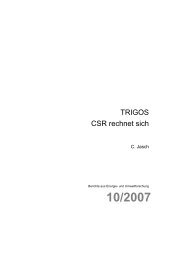Promoting Resource Efficiency in Small & Medium size ... - UNEP
Promoting Resource Efficiency in Small & Medium size ... - UNEP
Promoting Resource Efficiency in Small & Medium size ... - UNEP
You also want an ePaper? Increase the reach of your titles
YUMPU automatically turns print PDFs into web optimized ePapers that Google loves.
Each of the follow<strong>in</strong>g activities adds 1 kg of CO 2<br />
to the carbon footpr<strong>in</strong>t<br />
of a British person (calculated us<strong>in</strong>g the current UK mix of electricity<br />
and public transport):<br />
• Travel by public transportation (tra<strong>in</strong> or bus) a distance of 10 to 12<br />
km (6.5 to 7 miles)<br />
• Travel by car a distance of 6 km or 3.75 miles (assum<strong>in</strong>g 7.3<br />
litres petrol per 100 km or 39 mpg)<br />
• Fly on an aeroplane a distance of 2.2 km or 1.375 miles.<br />
• Operate your computer for 32 hours (60 Watt consumption<br />
assumed)<br />
• Production of 5 plastic bags<br />
• Production of 2 plastic bottles<br />
• Production of 1/3 of a cheeseburger<br />
2.5 Cleaner Production<br />
The term ‘Cleaner Production’ was first co<strong>in</strong>ed <strong>in</strong> September 1990 by<br />
<strong>UNEP</strong> and is def<strong>in</strong>ed as “the cont<strong>in</strong>uous application of an <strong>in</strong>tegrated<br />
environmental strategy to processes, products and services to <strong>in</strong>crease<br />
efficiency and reduce risks to humans and the environment.” 21<br />
Cleaner Production can be applied to the processes used <strong>in</strong> any<br />
<strong>in</strong>dustry, to products themselves and to various services provided <strong>in</strong><br />
society.<br />
For production processes, Cleaner Production is the result of one or<br />
a comb<strong>in</strong>ation of the follow<strong>in</strong>g: conserv<strong>in</strong>g raw materials, water and<br />
energy, elim<strong>in</strong>at<strong>in</strong>g toxic and dangerous raw materials, and reduc<strong>in</strong>g all<br />
emissions and wastes at the source.<br />
For products, Cleaner Production strategy focuses on reduc<strong>in</strong>g the<br />
environmental, health and safety impacts of the product over its entire<br />
life cycle from raw materials extraction to the ultimate disposal of the<br />
product.<br />
For services, Cleaner Production reduces the environmental impacts<br />
of the service provided over its entire life cycle: from design<strong>in</strong>g the<br />
system, its use, to the entire uptake of resources required to deliver the<br />
specific service.<br />
Thus, Cleaner Production is an approach to environmental management<br />
that aims to improve environmental performance by focus<strong>in</strong>g on the<br />
cause of environmental problems rather than the results. In this way, it<br />
is different from traditional ‘pollution treatment and control’ approaches.<br />
Cleaner Production is a pro-active, ‘anticipate and prevent’ philosophy.<br />
Cleaner Production is a ‘w<strong>in</strong>-w<strong>in</strong>’ strategy; it protects the environment,<br />
the consumer and the worker while improv<strong>in</strong>g <strong>in</strong>dustrial efficiency,<br />
profitability and competitiveness.<br />
Cleaner Production can therefore not only be applied to production<br />
processes, but it can also be applied throughout the life cycle of a<br />
product, from the <strong>in</strong>itial design phase, through to the consumption<br />
and disposal phase. It aims to ensure conservation of resources, the<br />
elim<strong>in</strong>ation of toxic raw materials, and the reduction of wastes and<br />
emissions.<br />
Five common generic techniques for implement<strong>in</strong>g Cleaner Production<br />
<strong>in</strong>clude:<br />
• Improved housekeep<strong>in</strong>g practices<br />
• Process optimisation<br />
• Raw material substitution<br />
• New technology<br />
• New product design<br />
Cleaner Production is an all-embrac<strong>in</strong>g strategy, which is directed<br />
towards reduc<strong>in</strong>g environmental impacts and risks by consider<strong>in</strong>g<br />
m<strong>in</strong>imisation of pollution at source by a diverse range of activities.<br />
Besides preserv<strong>in</strong>g environmental value, an important feature of<br />
Cleaner Production is that by prevent<strong>in</strong>g <strong>in</strong>efficient use of resources<br />
and avoid<strong>in</strong>g unnecessary generation of waste, companies benefit<br />
from reduced operat<strong>in</strong>g costs, reduced waste treatment and disposal<br />
costs and reduced liability. Invest<strong>in</strong>g <strong>in</strong> Cleaner Production to prevent<br />
pollution and reduce resource consumption is usually more costeffective<br />
than cont<strong>in</strong>u<strong>in</strong>g to rely on <strong>in</strong>creas<strong>in</strong>gly expensive ‘end-of-pipe’<br />
solutions.<br />
There are a number of analogous terms for Cleaner Production, such<br />
as eco-efficiency, green productivity and pollution prevention, among<br />
others, with slightly different focuses.<br />
For several sectors, strategies to approach the vision of zero waste<br />
appear feasible: <strong>in</strong> metal manufactur<strong>in</strong>g, steel or alum<strong>in</strong>ium scrap can<br />
be collected and reprocessed, oils can be collected and reprocessed or<br />
used as fuel to generate energy. In the paper <strong>in</strong>dustry, black liquor is<br />
recycled generat<strong>in</strong>g energy, waste paper is collected and the fibres can<br />
be reused for hygienic paper or kraft paper. In the food <strong>in</strong>dustry, waste<br />
can be collected and used as animal food; wastewater can be treated<br />
anaerobically to give methane, which then is used to generate electricity<br />
and heat.<br />
2.6 Safer Production for Hazardous Materials<br />
In the <strong>in</strong>dustrial environment a variety of hazardous substances,<br />
dangerous goods, and combustible liquids are used. Depend<strong>in</strong>g on<br />
their properties, hazardous materials can cause adverse health effects<br />
such as severe poison<strong>in</strong>g, sk<strong>in</strong> rashes, allergic reactions, cancer, as<br />
well as physical effects such as fire, explosion, release of hazardous<br />
gases and corrosion. When hazardous materials are not stored<br />
or handled correctly, they can cause harm to workers, neighbours<br />
and the environment due to their physical, chemical and biological<br />
properties. 22<br />
Examples of some hazardous materials <strong>in</strong>clude:<br />
• solvents<br />
• degreasers<br />
• clean<strong>in</strong>g chemicals<br />
• pa<strong>in</strong>ts<br />
• drugs<br />
• cosmetics<br />
• detergents<br />
• acids and caustics<br />
• refrigerant gases<br />
• metals such as lead, cadmium, chromium<br />
• gas cyl<strong>in</strong>ders<br />
• pesticides<br />
• herbicides<br />
• diesel fuel<br />
• petrol<br />
• liquefied petroleum gas<br />
21) <strong>UNEP</strong>, Susta<strong>in</strong>able Consumption & Production Branch, Cleaner Production, undated<br />
22) The State of Queensland (Department of Justice and Attorney-General) 2009, available from www.deir.qld.gov.au/workplace<br />
17



